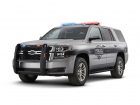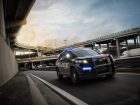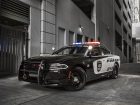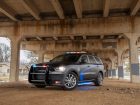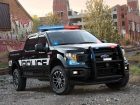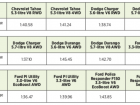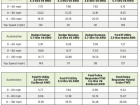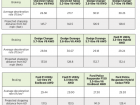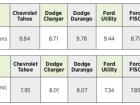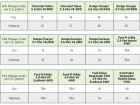
Features
2019 marks “one of the most interesting years for police cars in decades”
In one of the most significant years for police vehicles in North America, 2019 is poised to become the year of the SUV, plus the year that hybrid powertrains come standard on both a police category sedan and a police category SUV.
February 26, 2019 By Dave Brown
 The 2019 Chevrolet Tahoe
The 2019 Chevrolet Tahoe This may be one of the most interesting years for police cars in decades, and no one is giving up without a fight. All 12 entries are among the most mature, well-developed, well-designed police cars one could ever hope to drive.
While there is no official recognition of a pursuit-rated vehicle, police category vehicles are designed for the full spectrum of police work, including pursuits. Traditionally, a pursuit capable vehicle must be able to reach 60 MPH in 9.0 seconds, 100 MPH in 24.6 seconds, complete all 32 laps of the dynamic testing without major component failure, and maintain an average deceleration rate of 25.79 feet/sec2 while performing twenty threshold braking stops from 60 MPH in MSP tests.
As always, it will be up to the individual agencies to determine if a particular vehicle is suitable for their mission.
MICHIGAN STATE POLICE YEARLY VEHICLE TESTS
Every fall the Michigan State Police, in conjunction with the U.S. National Institute of Justice (NIJ) test the handling and performance of every new police vehicle on the market. These eagerly anticipated tests are seen as the most comprehensive analysis of police vehicles in North America.
Vehicles
The Michigan State Police Precision Driving Unit evaluates police vehicles in two categories: Police category vehicles and Special Service vehicles. Police category vehicles are designed for the full spectrum of general police activities including high-speed pursuit. Special service vehicles are designed only for specialized duties such as canine units or adverse weather conditions and are not intended or recommended for pursuits.
Twelve vehicles were submitted to the NIJ in the police category for the 2019 (and early 2020) model years:
• 2019 Chevrolet Tahoe PPV 5.3L RWD
• 2019 Chevrolet Tahoe PPV 5.3L 4WD
• 2019 Dodge Charger Pursuit 3.6L RWD
• 2019 Dodge Charger Pursuit 5.7L RWD
• 2019 Dodge Charger Pursuit 5.7L AWD
• 2019 Dodge Durango Pursuit 3.6L AWD
• 2019 Dodge Durango Pursuit 5.7L AWD
• 2020 Ford Police Interceptor Hybrid AWD
• 2020 Ford Police Interceptor Utility 3.0L EcoBoost AWD
• 2020 Ford Police Interceptor Utility 3.3L AWD
• 2019 Ford F-150 Police Responder 3.5L EcoBoost 4WD
• 2019 Ford Police Responder Hybrid Sedan FWD
THE TESTS
Michigan State Police Precision Driving Unit and the NIJ’s Justice Technology Information Center (JTIC) test all the vehicles together over a three-day period at the Chrysler Proving Grounds and the Grattan Raceway. Each vehicle is tested without rooftop lights, spotlights, sirens or radio antennas in place. Tires are original equipment rubber provided by the manufacturer.
Acceleration, braking and top speed tests are performed at the Chrysler proving ground and vehicle dynamics tests are done using the two-mile road course at the Grattan Raceway. (All dimensions and measurements are given in U.S. numbers.)
THE RESULTS
Vehicle dynamics testing
The objective of the vehicle dynamics testing is to determine the high-speed pursuit handling characteristics. Except for the absence of traffic, the two-mile road course simulates actual pursuit conditions. It evaluates the blend of suspension components and acceleration and braking ability.
Four different drivers test each vehicle over an eight-lap road course, with the five fastest laps counting toward each driver’s average lap time. Final score is the combined average of all four drivers for each vehicle.
Acceleration and top speed
The objectives of the acceleration and top speed tests are to determine the ability of each vehicle to accelerate from a standing start to 60 mph, 80 mph and 100 mph, and to record the top speed achieved within a distance of 14 miles from a standing start.
Each vehicle is driven through four acceleration sequences, two in each direction to allow for wind. Acceleration score is the average of the four tests. Following the fourth acceleration sequence, each vehicle continues to accelerate to its highest attainable speed within 14 miles.
Braking
The objective of the braking test is to determine the deceleration rate attained by each vehicle on twenty 60-0 mph full stops to the point of full ABS. Each vehicle is scored on the average deceleration rate it attains.
Each test vehicle makes five measured 60-0 mph stops to full ABS engagement in one direction, and then five measured 60-0 mph stops to full ABS engagement in the opposite direction. After 10 stops, each vehicle completes one lap around the test oval to cool the brakes, and the test is repeated.
The resulting score is the average of all 20 stops. Stopping distance from 60 mph is calculated by interpolation of results.
Communications and ergonomics
The objectives of the communications and ergonomics tests are to rate a vehicle’s ability to provide a suitable environment for officers to perform their job, to accommodate required communication and emergency warning equipment and to assess the relative difficulty in installing this equipment. A minimum of four officers independently evaluate ergonomic factors, and Michigan State Police Communications Division personnel then evaluate each vehicle on the ease of equipment installation.
A total of three communications factors are evaluated on a scale of one to 10 and averaged among all the testers. The final score is the overall average of all three factors, including dashboard, trunk and engine compartment accessibility.
A total of 27 ergonomic factors are evaluated on a scale of one to 10 and averaged among all the testers. The final score is the overall average of all 27 factors, such as seat design, padding, ease of entry, head room, instrument placement, HVAC control placement, visibility and ease of entry and exit.
Fuel economy
While not an indicator of actual mileage that may be experienced, the EPA mileage figures serve as a good comparison of mileage potential from vehicle to vehicle.
Vehicle figures are based on data published by the vehicle manufacturers and certified by the U.S. Environmental Protection Agency. Mileage figures are given in U.S. miles per gallon. Mileage figures for the Ford 2020 model year vehicles have not yet been released.
* Find this story as it appeared in the February 2019 edition HERE.
Dave Brown is Blue Line’s firearms and police vehicle contributor, as well as the Best Dressed Police Vehicle Awards judge. He is a tactical firearms trainer and consultant based in Winnipeg, Man. He can be reached at davebrown@blueline.ca.
Print this page
